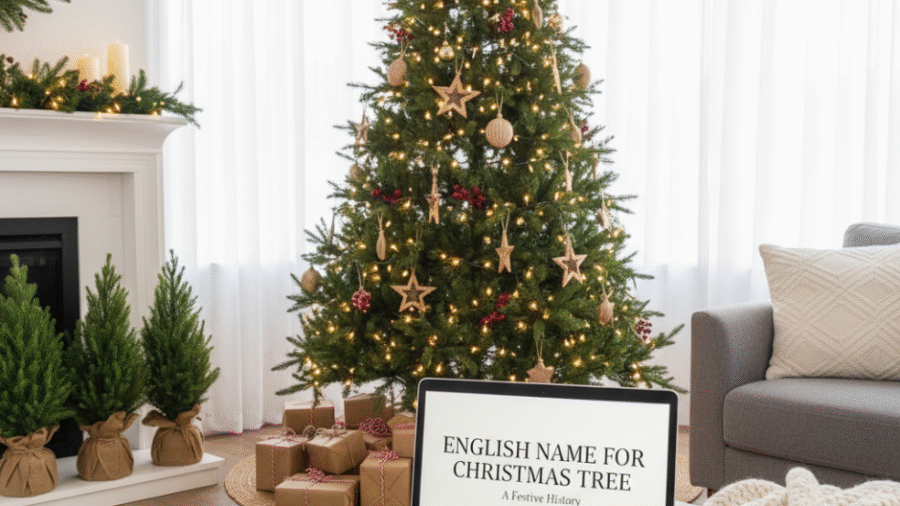The Christmas tree stands as one of the most recognizable symbols of the holiday season around the world. In English, the phrase “Christmas tree” is widely used, but it encapsulates a rich history, a variety of species, and even regional variations in naming and tradition. This article delves into the English term “Christmas tree,” its botanical specifics, synonyms, historical origins, and cultural significance to provide a thorough understanding of what this beloved symbol truly represents.
Understanding the Term “Christmas Tree” in English
The standard English name for the festive evergreen is simply “Christmas tree.” It refers to any evergreen tree—real or artificial—decorated as part of Christmas celebrations.
-
Typically, a Christmas tree is a coniferous evergreen such as a spruce, fir, or pine.
-
The phrase is common across all English-speaking countries including the UK, the United States, Canada, Australia, and New Zealand.
-
The term clearly connects the tree to the Christmas holiday, denoting both the physical tree and the cultural tradition involving decorating it with lights, ornaments, tinsel, garlands, and tree toppers.
In English dictionaries like the Cambridge Dictionary, the Christmas tree is defined as “a real or artificial fir tree that is decorated and kept in the home at Christmas”.
Botanical Background: Common Tree Species Used as Christmas Trees
In English, Christmas trees usually come from specific genera of conifers:
-
Fir trees (Abies): Among the most popular, including species like Fraser fir, noble fir, balsam fir, and concolor fir.
-
Spruce trees (Picea): Including Norway spruce, blue spruce, and white spruce.
-
Pine trees (Pinus): Scotch pine being a widespread choice.
-
Other less common species include Douglas fir, cedar, and cypress.
The English terminology often will specify the species, for example, “Fraser fir Christmas tree” or “Norway spruce Christmas tree.” These species differ in needle shape, scent, and durability but all fall under the umbrella term “Christmas tree”.
Synonyms and Related Terms in English
While “Christmas tree” is the primary term, some synonyms or variants exist, especially in different contexts:
-
Holiday tree: Sometimes used in secular contexts to make the decoration more inclusive of various cultural traditions.
-
Yule tree: Refers to the Christmas tree’s roots in pre-Christian Yule festivals; not as commonly used but featured in historical or folkloric discussions.
-
Fir tree / Pine tree / Spruce tree: When emphasizing the biological aspect without the Christmas context.
-
Artificial Christmas tree: To specify a man-made tree imitation versus a real one.
The Historical and Cultural Evolution of the Christmas Tree
The term “Christmas tree” in English-speaking regions is closely tied to the tradition that originated in Germany in the 16th century and became popular in Britain and North America during the 19th century.
-
Early German Christians referred to it as “Weihnachtsbaum” (Christmas tree in German).
-
Queen Victoria and Prince Albert popularized the Christmas tree in Britain, introducing the tradition to English language audiences.
-
The custom spread through English-speaking countries under the shared terminology of “Christmas tree” during the Victorian era.
Christmas Tree – Symbolism and Usage in English Culture
In English cultural usage, the Christmas tree is more than just a decoration; it is a symbol of:
-
Celebration and joy: An centerpiece for holiday festivities.
-
Hope and renewal: Representing eternal life due to its evergreen nature.
-
Community and family: A focus point for bonding and traditions.
Interesting Variations: Named Trees and Regional Terms
-
In Scotland and parts of northern England, the Christmas tree is sometimes nicknamed the “Yule tree,” linking it to ancient winter solstice traditions.
-
Modern inclusive language has borrowed “holiday tree” in diverse communities to bridge cultural differences.
Read More: What Are the Benefits of a Real Christmas Tree? Exploring Environmental, Health, and Emotional Advantages
Conclusion
The English name for Christmas tree is simply “Christmas tree,” but this humble term encompasses a vast tradition of botanical variety, rich cultural history, and festive meaning. Whether referring to a Fraser fir, a Norway spruce, or a synthetic replica, the Christmas tree remains a universal symbol of Christmas spirit in English-speaking cultures.
Understanding the term’s botanical and cultural layers enriches appreciation, revealing why this evergreen continues to bring joy each holiday season.



Add a Comment